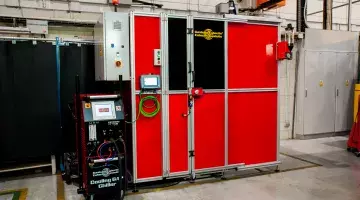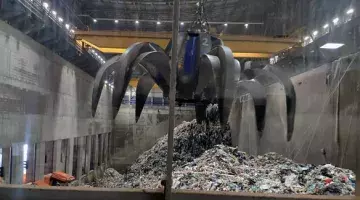Sustainable wear-resistant solutions cut downtime for pulp and paper plant

Wear of vital machine components is a significant issue for the pulp and paper industry. It results in added costs for repairs, replacement, and ongoing maintenance, as well as the cost of lost production.
Pulp and paper machinery is subject to various different types of wear such as abrasion, impact, erosion, fatigue, corrosion, heat, and combinations of these. Since 1906, Castolin Eutectic has been developing and applying innovative wear solutions that can boost productivity and can also help improve energy efficiency and reduce their CO2 footprint.
This article outlines the practical advantages of wear protection in key processes throughout the pulp and paper production process.
Woodyard conveyor system
The conveyor chain sprocket is a key element in the woodyard conveyor system. The teeth on the sprocket are subjected to high levels of wear. Building up the teeth with two different layers of welding wire will reduce wear significantly. This solution can extend the wear life of the chain sprocket by 200%.
The links of the chain itself wear smooth on top from abrasion which causes log slippage on the conveyor. It is much worse in the winter. This can be addressed by coating each link with a fusible alloy that blends coarsely-sized tungsten carbide and nickel-base alloy powder. This solution is known to last for over five years with no sign of wear or lack of traction.
Mulching
The lumber and paper industries use the bark and wood waste from debarking in several ways. Bark preparation uses hammer mills, conveyors, feed screws, and fans. All of this equipment is subject to wear from the abrasive action of the bark and wood waste.
Some sites use hog shredders, where the hammer tips take most of the wear from shredding bark and wood. Foreign materials like nails, wires, etc. cause additional wear. Rebuilding the tips with welding and coating with powder can increase tip life by over 100%
Other installations with bark crushing machines experience rapid wear on the ejection strip installed at the exit. It wears quickly due to the high abrasion and erosion. In one case, replacing the original plate manufactured from wear-resistant steel with a CDP® (CastoDur Diamond Plate) solution based on composite bi-metallic materials has increased the service life by 200%.

Chip transfer and cyclones
Within mills, chips are commonly transported either pneumatically within pipes or on conveyor belts. Other systems such as chain and screw conveyors are also used to move chips.
In one case, strong erosion was found on a lifting tube situated on the exit of the chipper to the cyclone. Although wear-resistant steel had been used, a customer had found the unit failed prematurely. A replacement was manufactured from new using CDP® wear plate. The outer side edges were reinforced with an iron profile and welded with a specially selected wire. The internal weld seams were also hard surfaced with welding wire. The result was a 400% increase in service life.
Fan rotors also suffer from severe erosive wear due to the mixture of wood, sand and dust in the air stream. For one repair, where the wear was found to be very localized, tailor-made CDP® wearplate strips were cut and formed to suit. The joints were overlaid with protective welding. After two years, no signs of wear had occurred, confirming a very significant increase in the fan’s working life.
Screening and storage
Chips of acceptable size must be isolated from undersized (fines) and oversized pieces by passing the chips over a series of screens. In recent years, chip thickness has come to be recognized as an important pulping variable, this means that wear must be minimized in order to maintain the accuracy of the screening operation.
A chip screen separator has disks with points that wear from chip abrasion. Excessive wear would allow large chips to pass through to the digester. To rectify one worn unit, the surfaces of the points were ground and powder was applied by a spray fusing process. This solution allowed an in-situ repair to be carried out, with no need to take the unit apart, remove the screen disk and replace it. Major cost savings resulted since downtime was reduced and there was no need to purchase a replacement part.
Pulping
Pulping refers to any process by which wood is reduced to a fibrous mass. It can be accomplished mechanically, thermally, chemically, or by combinations of these treatments.
The discharge elbow of batch digesters is subjected to severe corrosion, erosion, abrasion and thermal shock from cooking liquor, pulp and steam. In one example, worn areas in the elbow and piping were built up with welding electrodes developed for critically stressed areas. The faces of flanges were also overlaid in a similar way and machined to finish. This enabled wear life to be extended three times over that of the original elbow.
Washing
The cooked pulp from the digesters must be washed to remove residual liquor that would contaminate the pulp during subsequent processing steps and recover the maximum amount of spent chemicals with minimum dilution.
Corrosion and metal fatigue causes the washer screens to break and crack. Using a brazing rod with high silver content gives a quick and strong repair with its high tensile strength and low bonding temperature.
Bleaching
Modern bleaching is achieved through a continuous sequence of process stages utilizing different chemicals and conditions in each stage, usually with washing between stages. Washers and pumps in the bleaching operation must be made from high-alloy stainless steels, nickel alloys, and titanium. Controlling chemical corrosion in the bleaching equipment is an ongoing problem.
A particular challenge is the refiner disk that suffers from stress corrosion cracking and wear at the transition area between the disk and cylinder. This can be repaired by sandblasting and then arc-spraying with a coating based on the nickel-chromium alloy 625.
Processing
In most pulp and paper processes, some type of stock screening operation is required to remove oversized, troublesome and unwanted particles from good papermaking fibers. All the major types of stock screens depend on some form of perforated barrier to pass acceptable fibers and reject the unwanted material.
Further preparation of the pulp stock is refining of the fibers. Two major types of continuous refiners are used for stock preparation: disc refiners and conical refiners.
Efficient movement of a stock through the various processing steps is at the heart of a pulp and paper mill operation.
One challenge is found on the refiner shaft, where the stainless steel sleeve is worn by fretting from the collar bush that holds it in place, this wear is accelerated by corrosion. This can be solved by spraying the shaft with a torch-fused powder developed to prevent corrosion and reduce friction. The lifetime can be increased by 300% due to the superior hardness, corrosion resistance, and sliding properties of the coating.
Scrap paper and cardboard
Many pulp and paper mills use recycled paper and cardboard as another source for papermaking pulp. Some mills operate with only recycled materials. The scrap is fed into a hydrapulper, which is a vertical tub with a revolving rotor at the bottom. Paper and cardboard with water are shredded by the rotor into pulp and a perforated extraction plate under the rotor pulls the fibers out of the tub. Further cleaning and de-flaking of the pulp prepares it for papermaking. The rotor in the hydrapulper is subjected to high wear from the wastepaper as well as foreign materials such as stones and scrap metal.
In one case repair was required on the impeller at the bottom of the tank. The production capacity decreases dramatically when the impeller is worn out. For the repair, critical areas were protected by welding with electrodes developed to offer combined protection against abrasion, pressure and moderate impact. In addition to increasing the lifetime from 2 weeks to 5 months, the welding can be carried out three times to further reduce costs.

Lime kilns
One of the major challenges in the manufacturing of pulp has always been the maintenance and operating efficiency of the lime kilns in the causticizing plant. Since they are lined with fire-resistant refractory brick, constantly rotating on rollers, and heated internally to 1450°C, they are susceptible to serious operating and maintenance problems. The longer the kiln, the greater these problems can be, especially with respect to cracking and misalignment of the rollers.
A successful repair was made possible using low-heat welding electrodes and a tightly controlled procedure. Significant cost savings were achieved as no new part was required and the downtime was cut from 10 weeks to 2 weeks.

Repair and refurbishment often achieve better results than replacement
The first instinct of maintenance teams in the pulp and paper industry is often to replace worn parts with brand new items. However, in this industry, continuity of operation is usually the primary concern. Therefore, repair and refurbishment can prove superior in many cases. As well as ensuring a faster return to action, using the latest wearfacing technology can also significantly improve operational life, often several times over. The result is greater reliability, improved sustainability and the best possible total cost of ownership.



